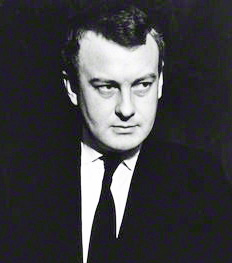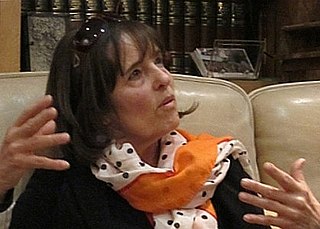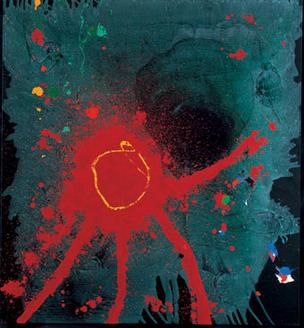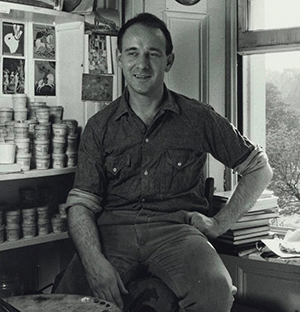
Patrick Joseph Caulfield,, was an English painter and printmaker known for his bold canvases, which often incorporated elements of photorealism within a pared-down scene. Examples of his work are Pottery and Still Life Ingredients.

Sir Peter Thomas Blake is an English pop artist. He co-created the sleeve design for the Beatles' 1967 album Sgt. Pepper's Lonely Hearts Club Band. His other works include the covers for two of The Who's albums, the cover of the Band Aid single "Do They Know It's Christmas?", and the Live Aid concert poster. Blake also designed the 2012 Brit Award statuette.

The Brotherhood of Ruralists is a British art group founded in 1975 in Wellow, Somerset, to paint nature. Their work is figurative with a strong adherence to 'traditional' skills. Painting in oil and watercolour predominate, with mixed media assemblage, printmaking, ink and pencil drawing also being common. It has been described as "a kind of late twentieth-century reinvention of William Morris's arcadian craft guilds."

Bryan Robertson OBE was an English curator and arts manager described by Studio International as "the greatest Director the Tate Gallery never had".
Ivon Hitchens was an English painter who started exhibiting during the 1920s. He became part of the 'London Group' of artists and exhibited with them during the 1930s. His house was bombed in 1940 during World War II. Hitchens and his family abandoned London for the Sussex countryside, where he acquired a small area of woodland on Lavington Common, and lived there in a caravan, which he gradually augmented with a series of buildings. It was here that the artist further developed his fascination with the woodland subject matter, and this pre-occupation continued until the artist's death in 1979.
Graham Arnold was an English contemporary fine artist, working primarily in oil and mixed media.
Ann Dinah Ovenden is a British fine artist and a founder member of the Brotherhood of Ruralists. She is a figurative artist.

John Ronald Craigie Aitchison CBE RSA RA was a Scottish painter. He was best known for his many paintings of the Crucifixion, one of which hangs behind the altar in the chapter house of Liverpool Cathedral, Italian landscapes, and portraits. His simple style with bright, childlike colours defied description, and was compared to the Scottish Colourists, primitivists or naive artists, although Brian Sewell dismissed him as "a painter of too considered trifles".

Jann Haworth is a British-American pop artist. A pioneer of soft sculpture, she is best known as the co-creator of The Beatles' 1967 Sgt. Pepper's Lonely Hearts Club Band album cover. Haworth is also an advocate for feminist rights especially for the representation of women in the art world.

John Hoyland RA was a London-based British artist. He was one of the country's leading abstract painters.

Luke Andrew Cary Elwes is a British contemporary artist whose paintings capture his encounters with the landscape and with the elements. He gained prominence in the early nineties when he returned from his travels in India, Asia and North Africa with a series of key paintings.
Graham Stuart Ovenden was an English painter, fine art photographer and writer.
Timothy Hyman was a British figurative painter, art writer and curator. He published monographs on both Sienese Painting and on Pierre Bonnard, as well as most recently The World New Made: Figurative Painting in the Twentieth Century. He wrote extensively on art and film, was a regular contributor to The Times Literary Supplement (TLS) and curated exhibitions at the Tate, Institute of Contemporary Arts and Hayward galleries. Hyman was a portraitist but is best known for his narrative renditions of London. Drawing inspiration from artists such as Max Beckmann and Bonnard, as well as Lorenzetti and Brueghel, he explored his personal relationship, both real and mythological, with the city where he lived and worked. He employed vivid colours, shifting scale and perspectives, to create visionary works. He was elected an RA in 2011.
Ken Kiff, was an English figurative artist, who was born in Dagenham and trained at Hornsey School of Art 1955-61. He came to prominence in the 1980s thanks to the championship of art critic Norbert Lynton, and a cultural climate intent on re-assessing figurative art following the Royal Academy's ‘New Spirit in Painting’ exhibition in 1981. He started exhibiting at Nicola Jacob's gallery, moved to Fischer Fine Art in 1987, and finally to the Marlborough Gallery in 1990, by which time he had begun exhibiting internationally and had work in major public collections. He was elected to the Royal Academy of Arts in 1991 and became Associate Artist at the National Gallery 1991–93. His 30-year teaching career at Chelsea School of Art and the Royal College influenced a generation of students.

Derek Balmer is a British artist and photographer, Past President of the Royal West of England Academy (2001–10) and Pro-Chancellor of the University of the West of England (2001–10) to Chancellor Dame Elizabeth Butler-Sloss. He received an Honorary Doctorate from the University of the West of England in 2001.

Ivor Abrahams was a British sculptor, ceramicist and print maker best known for his polychrome sculptures and his stylised prints of garden scenes. His career long exploration of new subject matter, novel techniques and materials made his art dealer, James Mayor, describe him as Europe's equivalent of Robert Rauschenberg.

The Badminton Game is a painting of 1973 by the English painter David Inshaw. It was inspired by the gardens of Devizes and the landscape of Wiltshire. Inshaw has described how the place gave him a feeling of "mystery and wonder". He wrote about the painting: "my main aim was to produce a picture that held a moment in time, but unlike a photograph, which only records an event. I thought a painting could give a more universal, deeper meaning to that moment by composing one instant from lots of different unrelated moments." Its original title was a line from Thomas Hardy's poem "She, to Him": Remembering mine the loss is, not the blame.
Born in South Africa, Michael Edward Bolus was an artist and teacher who settled in England in 1957 and studied at St Martin's School of Art from 1958 to 1962, studying under Anthony Caro. After a brief period living in Cape Town he returned to London in 1964 to begin a teaching post at St Martin's and the Central School of Art and Design. Bolus had his first UK solo exhibition at Waddington Galleries in 1968, which has exhibited a number of his sculptures since then.

The River Bank (Ophelia) is a 1980 painting by the English painter David Inshaw. The subject is from William Shakespeare's play Hamlet. It was made for a joint exhibition of the Brotherhood of Ruralists, where each artist made his own interpretation of the subject. Since 2015 it belongs to the Victoria Art Gallery in Bath, Somerset.

Adrian Berg was an English painter known for his landscapes, many of them images of Regent's Park, London. Although some of his works appear almost naturalistic, typically they defy conventional notions of perspective and coloration. Instead they combine multiple viewpoints and time periods in a single image. His paintings are included in the permanent collections of the British Council, the British Museum, the European Parliament, the Royal Academy of Arts, the Tate, and the Victoria and Albert Museum, among others.















